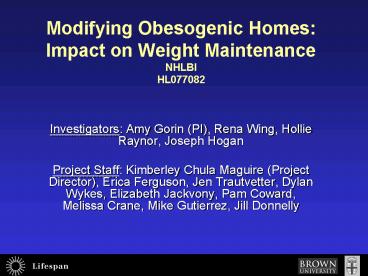Modifying Obesogenic Homes: Impact on Weight Maintenance NHLBI HL077082 - PowerPoint PPT Presentation
1 / 16
Title:
Modifying Obesogenic Homes: Impact on Weight Maintenance NHLBI HL077082
Description:
Motivational posters. Control portions of meals consumed in home ... Motivational posters. Decreasing cues for sedentary activity ... – PowerPoint PPT presentation
Number of Views:48
Avg rating:3.0/5.0
Title: Modifying Obesogenic Homes: Impact on Weight Maintenance NHLBI HL077082
1
Modifying Obesogenic Homes Impact on Weight
MaintenanceNHLBIHL077082
- Investigators Amy Gorin (PI), Rena Wing, Hollie
Raynor, Joseph Hogan - Project Staff Kimberley Chula Maguire (Project
Director), Erica Ferguson, Jen Trautvetter, Dylan
Wykes, Elizabeth Jackvony, Pam Coward, Melissa
Crane, Mike Gutierrez, Jill Donnelly
2
Obesity Trends Among U.S. Adults2005
(BMI 30, or 30 lbs overweight for 5 4 woman)
No Data lt10 1014
1519 2024 2529
30
Source Behavioral Risk Factor Surveillance
System, CDC.
3
Health Impact of Excessive Weight
- CVD
- Diabetes
- Gallbladder disease
- Respiratory disease
- Arthritis
- Cancer
- ________________________
- 60 billion in direct medical costs
- and 100,000 deaths each year
4
Behavioral Weight Control
- Antecedents Behavior Consequences
- Self-monitoring
- Stimulus control
- Problem solving
- Social support
- Goal setting
- Cognitive restructuring
- Relapse prevention
5
The Good News
- Modest weight losses (5-10 of body weight) and
increases in physical activity can decrease the
risk of diabetes and other health problems by
more than 50
6
The Bad News
Wadden et al., 1989
Treatment
Follow-up
TIME IN WEEKS
7
An Ecological Model of Obesity (NHLBI)
Developed for the NHLBI Workshop on Predictors of
Obesity, Weight Gain, Diet, and Physical
Activity August 4-5, 2004, Bethesda MD
8
An Ecological Model of Obesity (NHLBI)
Developed for the NHLBI Workshop on Predictors of
Obesity, Weight Gain, Diet, and Physical
Activity August 4-5, 2004, Bethesda MD
9
- Overweight and obese (BMI 25-50 kg/m2) adults
randomly assigned to 18 months of - 1) standard behavioral treatment
- 2) SBT direct manipulation of physical and
social home environment
10
Goal 1 Modify the type and portion sizes of
foods consumed in the home
- Alter food cues in the home
- Cabinet Cleanouts and Filling up with Fit Foods
- Subscription to healthy eating magazine
- Motivational posters
- Control portions of meals consumed in home
- Serving size appropriate plates and glasses
- Food provision via Peapod
- In pilot study, this decreased of high fat
foods in the home from 27 to 17, significantly
more than SBT
11
Goal 2 Modify the availability of exercise
equipment and sedentary activities in
the home
- Provision of treadmill or exercise bike
- Enhancing visual cues for exercise
- Subscription to exercise magazine
- Motivational posters
- Decreasing cues for sedentary activity
- Limiting access to TVs with TV Allowance
- In pilot, reduced household TV time by 50
12
Goal 3 Increase the saliency of the consequences
of eating and exercise choices
- Provided with digital scale and full length
mirror - Instructed to place items in prominent locations
in home
13
Goal 4 Create a positive model for healthy
eating and exercise in the home
- Required to bring an overweight, adult partner
who lives in the same house to treatment - Partner sets weight loss goal and makes similar
changes in eating and exercise - Based on prior work showing that bringing a
partner is only effective when the partner is
also successful
14
LEAP Study Outcomes
- Participants and partners assessed at 0, 6, 12,
and 18 m - Weight
- Weight-related behaviors
- Dietary intake
- Physical activity
- TV viewing
- Other variables
- Depression
- Quality of life
- Reasons for wanting to lose weight
- Alcohol use and smoking
15
Assessing the Home Environment
Home visits at 0, 6, and 18 m
- Social home environment
- Type of support (autonomous vs. controlled) from
partner - Household support how supportive each person is
of participants weight control efforts and
whether or not they are interested in changing
their own eating and exercise - Sallis Support Measure
- Physical home environment
- Type and placement of food
- Type and placement of exercise equipment
- of TVs
- TV in the bedroom
- Scale, full length mirror
- Healthy eating and exercise magazines
16
Study Progress
- Recruitment
- 201 pairs (402 individuals) enrolled in the study
- 50.510.8 years
- 78.6 women
- 21.4 minority participation
- Retention
- 97 at 6 m
- 89 at 12 m
- 95 at 18 m (2 out of 6 waves completed)































